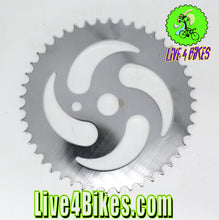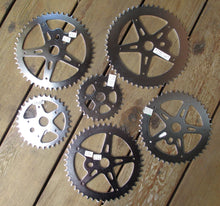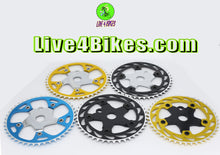Enhance Your Ride with the Steel Chainring
d62-546 - A Chrome/Black Marvel
Introduction: In the world of cycling, the smallest components can make a significant difference in performance and style. The Steel Chainring ZT7B-D 44T in Chrome/Black is a prime example of how attention to detail can elevate your cycling experience. In this article, we'll delve into the features and advantages of the Steel Chainring ZT7B-D 44T and explain why Live4Bikes is the ideal destination for securing this essential upgrade.
Key Specifications:
- Teeth Count: 44T (44 Teeth).
- Chain Compatibility: 1/2" X 1/8" chains (Designed for single-speed setups).
- Crank Compatibility: Suitable for 1-piece cranks.
- Tooth Type: Standard.
- Material: Crafted from durable steel.
- Color: Sleek Chrome/Black finish.
Unveiling the Advantages of the Steel Chainring 44T:
-
Optimal Tooth Count: With 44 teeth, this chainring provides an excellent balance between speed and power. It's ideal for single-speed setups, ensuring you can tackle various terrains with ease.
-
1/2" X 1/8" Chain Compatibility: Designed for 1/8" width chains, this chainring is known for its durability and reliability, making it a top choice for riders who prioritize low maintenance and a smooth ride.
-
1-Piece Crank Compatibility: Designed to fit 1-piece cranks, this chainring is versatile and can be easily integrated into various bike setups, making it a popular choice among cyclists with diverse needs.
-
Durable Steel Construction: Crafted from sturdy steel, the Steel Chainring ZT7B-D 44T is built to withstand the demands of cycling. It promises longevity, ensuring you won't need to worry about frequent replacements.
-
Sleek Chrome/Black Finish: The Chrome/Black finish not only adds a touch of style to your bike but also enhances its aesthetics. Whether you're upgrading an existing bike or customizing a new build, this chainring will undoubtedly elevate the overall look of your ride.
A 1-piece 44T chainring sprocket can fit on various types of bicycles, but it's important to consider a few factors:
-
Bike Type: This type of sprocket can be used on single-speed bikes or bikes with internal hub gears that don't require a derailleur.
-
Bottom Bracket Type: The compatibility also depends on the type of bottom bracket your bike has. The sprocket needs to be compatible with the bottom bracket's interface.
-
Chain Type: Make sure the chain that you're using is compatible with a 44T chainring. The chain must have the appropriate width and link count.
-
Frame Clearance: Ensure that there is enough clearance on your frame for a 44T chainring. Some frames may not have enough clearance for a chainring of this size.
-
Crank Arm Length: The length of the crank arms also matters. The crank arms should be compatible with the chainring size to ensure proper chain alignment.
-
Use Case: Consider what type of riding you'll be doing. A 44T chainring is typically used for applications that require more torque, like commuting or off-road riding.
Remember that if you're unsure about compatibility, it's always a good idea to consult with a bike shop or a professional bike mechanic. They can provide specific advice based on the details of your bike.

Bicycle chainrings play a crucial role in the efficiency and performance of your bike. They are the toothed rings that attach to your crankset and engage with the bicycle chain. When it's time to replace a worn-out or damaged chainring, it's important to understand what factors to consider. In this guide, we'll cover the key aspects you need to keep in mind when buying a replacement.
1. Understanding Chainring Basics
a. Chainring Size
Chainrings are measured by the number of teeth they have. For example, a chainring with 52 teeth is larger than one with 42 teeth. The size affects the gearing ratio, influencing how easy or hard it is to pedal.
b. BCD (Bolt Circle Diameter)

This is a crucial measurement to get right. The BCD is the diameter of the circle that passes through the centers of the chainring bolts. It's important because it determines whether a chainring will fit on your crankset. Common BCD sizes include 110mm, 130mm, and 144mm, but there are others as well.

2. What to Measure
a. Number of Bolts
Check how many bolts secure your chainring to the crankset. This is typically either 4 or 5 bolts. It's important to get a replacement with the same number of bolts to ensure a secure fit.
b. BCD Measurement
To measure BCD, you'll need a ruler or caliper. Place one arm on the center of a bolt hole and measure to the center of the hole directly opposite. If you're not confident in your measurement, it's best to consult a professional or use specialized tools.

|
 |
 |
3. Things to Ensure Match
a. BCD Compatibility
Ensure that the BCD of your new chainring matches the BCD of your crankset. A chainring with the wrong BCD will not fit properly and can lead to poor shifting and potential damage.
b. Teeth Count
If you're happy with your current gear ratios, it's a good idea to stick with a similar number of teeth on your replacement chainring. However, if you want to adjust your gear ratios, you can experiment with different tooth counts.

|
 |
 |
a. Ignoring Wear and Tear
Don't delay replacing a worn chainring. A worn chainring can lead to poor shifting, chain slippage, and accelerated wear on other drivetrain components.
b. Mixing Incompatible Components
Avoid trying to force a chainring with the wrong BCD onto your crankset. This can lead to damage to both the chainring and the crankset.
Choosing the right replacement chainring involves understanding key measurements like BCD, teeth count, and bolt number. It's crucial to ensure compatibility with your existing components to maintain smooth and efficient operation. Remember, if you're uncertain, seeking advice from a professional at your local bike shop is always a wise move. With the right replacement, your bike will continue to perform at its best.






